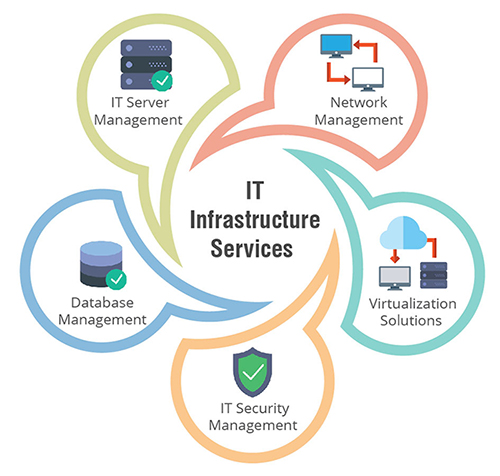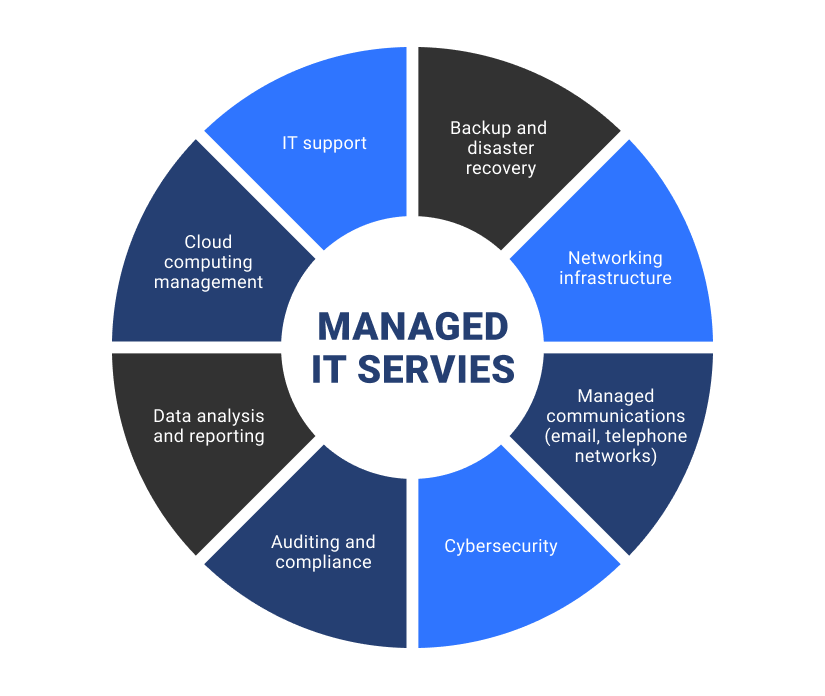
In today’s fast-paced digital landscape, businesses rely heavily on robust IT infrastructure services to support their operations, facilitate communication, and drive innovation. From cloud computing to network security, the realm of IT infrastructure encompasses a wide range of technologies and practices that are crucial for maintaining the efficiency, reliability, and security of organizational systems. In this comprehensive guide, we will explore the intricacies of IT infrastructure services, covering key components, best practices, emerging trends, and challenges faced by organizations in managing their infrastructure effectively.
Understanding IT Infrastructure Services:
IT infrastructure services encompass a broad spectrum of technologies, tools, and practices that enable businesses to build, deploy, and manage their digital infrastructure. This includes hardware components such as servers, storage devices, and networking equipment, as well as software solutions for virtualization, data management, and cybersecurity. IT infrastructure services are essential for supporting core business functions, delivering digital services to customers, and ensuring the reliability and security of critical systems.
Key Components of IT Infrastructure:
A robust IT infrastructure consists of several key components, each playing a crucial role in supporting business operations and delivering value to stakeholders. These components include:
- Servers: The backbone of any IT infrastructure, servers provide computing resources for running applications, storing data, and hosting websites and services. Servers come in various forms, including physical servers, virtual machines, and cloud instances.
- Storage: Storage solutions enable organizations to store and manage vast amounts of data efficiently. This includes storage area networks (SANs), network-attached storage (NAS), and cloud storage services.
- Networking: Networking infrastructure facilitates communication between devices, systems, and users within an organization and across the internet. This includes routers, switches, firewalls, and network protocols.
- Virtualization: Virtualization technology allows organizations to optimize resource utilization, improve scalability, and enhance flexibility by running multiple virtual machines or containers on a single physical server.
- Security: Security infrastructure protects sensitive data, systems, and networks from cyber threats, unauthorized access, and data breaches. This includes firewalls, intrusion detection systems (IDS), encryption, and access control mechanisms.
Best Practices for Managing IT Infrastructure:
Effective management of IT infrastructure requires adherence to best practices and industry standards to ensure reliability, security, and scalability. Some key best practices include:
- Regular Maintenance: Perform routine maintenance tasks such as software updates, security patches, and hardware upgrades to keep systems running smoothly and minimize downtime.
- Disaster Recovery Planning: Develop and implement a comprehensive disaster recovery plan to mitigate the impact of system failures, natural disasters, and cyber attacks on business operations.
- Performance Monitoring: Monitor system performance, network traffic, and resource utilization to identify bottlenecks, optimize performance, and proactively address issues before they impact productivity.
- Backup and Data Protection: Implement robust backup and data protection measures to safeguard critical data and ensure business continuity in the event of data loss or corruption.
- Compliance and Governance: Adhere to industry regulations, data protection laws, and compliance standards relevant to your organization’s industry to mitigate legal and regulatory risks and maintain trust with customers and stakeholders.
Emerging Trends in IT Infrastructure:
The field of IT infrastructure is constantly evolving, driven by technological advancements, changing business requirements, and emerging trends. Some notable trends shaping the future of IT infrastructure services include:

- Cloud Computing: The adoption of cloud computing continues to grow rapidly, enabling organizations to leverage scalable, on-demand resources and reduce capital expenditure on hardware and infrastructure.
- Edge Computing: Edge computing brings compute resources closer to the point of data generation, enabling faster processing, reduced latency, and improved performance for latency-sensitive applications.
- DevOps and Automation: DevOps practices and automation tools streamline software development, deployment, and operations, enabling organizations to achieve greater agility, efficiency, and collaboration.
- Artificial Intelligence and Machine Learning: AI and machine learning technologies are being increasingly integrated into IT infrastructure solutions to automate tasks, improve decision-making, and enhance security.
- Hybrid and Multi-Cloud Deployments: Many organizations are adopting hybrid and multi-cloud strategies to leverage the benefits of both on-premises and cloud-based infrastructure while maintaining flexibility and control over their IT environment.
Challenges and Considerations:
Despite the benefits of IT infrastructure services, organizations face several challenges and considerations in managing their infrastructure effectively. These challenges include:
- Security Threats: Cybersecurity threats such as malware, ransomware, and phishing attacks pose a significant risk to IT infrastructure, requiring robust security measures and proactive threat detection and response strategies.
- Data Management: Managing and securing vast amounts of data generated by modern IT infrastructure can be challenging, requiring effective data management, storage, and backup solutions.
- Scalability and Flexibility: As businesses grow and evolve, they need IT infrastructure solutions that can scale dynamically to accommodate changing demands and support new applications and services.
- Complexity and Integration: Integrating disparate IT infrastructure components and managing complex, heterogeneous environments can be challenging, requiring careful planning, coordination, and expertise.
- Cost Management: Balancing the cost of IT infrastructure services with the need for performance, reliability, and security requires careful budgeting, cost optimization strategies, and vendor management.
IT infrastructure services play a critical role in supporting modern businesses, enabling them to innovate, compete, and succeed in today’s digital economy. By understanding the key components, best practices, emerging trends, and challenges associated with IT infrastructure management, organizations can optimize their infrastructure to achieve greater efficiency, reliability, and security. Whether leveraging cloud computing, embracing DevOps practices, or implementing edge computing solutions, businesses must adapt to the evolving landscape of IT infrastructure to meet the demands of a rapidly changing world.

Navigating the Complexities of IT Infrastructure Services
Businesses rely heavily on robust IT infrastructure to support their operations, facilitate communication, and drive innovation. However, the landscape of IT infrastructure services is constantly evolving, shaped by technological advancements, changing business requirements, and emerging trends. In this comprehensive analysis, we will explore the evolution of IT infrastructure services, highlighting key trends, addressing common challenges, and identifying opportunities for businesses to optimize their infrastructure in the modern age.
· The Rise of Cloud Computing:
The advent of cloud computing has revolutionized the way businesses approach IT infrastructure. Instead of relying solely on on-premises hardware and software, organizations are increasingly turning to cloud-based services for their computing, storage, and networking needs. Cloud computing offers numerous benefits, including scalability, flexibility, and cost-efficiency. By leveraging cloud infrastructure, businesses can rapidly provision resources, scale dynamically to meet fluctuating demand, and reduce capital expenditure on hardware and maintenance.
Major cloud service providers, such as Amazon Web Services (AWS), Microsoft Azure, and Google Cloud Platform (GCP), have emerged as leaders in the cloud computing market, offering a wide range of services tailored to meet the diverse needs of businesses. From Infrastructure as a Service (IaaS) to Platform as a Service (PaaS) and Software as a Service (SaaS), cloud providers offer a comprehensive suite of solutions to support various workloads and applications.
· Hybrid Infrastructure Models:
While cloud computing has gained significant traction, many organizations continue to maintain on-premises infrastructure alongside cloud deployments. This hybrid approach allows businesses to leverage the benefits of both environments while addressing concerns related to data sovereignty, compliance, and latency. Hybrid infrastructure models combine on-premises resources with public and private cloud services, enabling organizations to optimize workload placement, achieve greater flexibility, and maintain control over sensitive data.
Hybrid cloud solutions provide a seamless integration between on-premises data centers and cloud environments, allowing for workload portability, data synchronization, and unified management. By adopting a hybrid infrastructure model, businesses can achieve a balance between agility and security, ensuring that critical workloads are deployed in the most suitable environment based on performance, compliance requirements, and cost considerations.
· Security and Compliance Challenges:
As organizations transition to cloud-based infrastructure, security and compliance become paramount concerns. With the proliferation of cyber threats and data breaches, safeguarding sensitive information and maintaining regulatory compliance are top priorities for businesses across all industries. Cloud providers invest heavily in security measures, including encryption, identity and access management, and threat detection, to protect customer data and ensure compliance with industry regulations.
However, achieving robust security in the cloud requires a shared responsibility model, where both the cloud provider and the customer are responsible for implementing appropriate security controls. Businesses must assess their security posture, identify potential vulnerabilities, and implement best practices for securing cloud workloads and data. Additionally, compliance regulations such as GDPR, HIPAA, and PCI DSS impose strict requirements on the handling and protection of sensitive data, further complicating the security landscape for businesses operating in regulated industries.
· Automation and DevOps Practices:
To effectively manage modern IT infrastructure, organizations are increasingly embracing automation and DevOps practices to streamline deployment, configuration, and management processes. Automation tools and platforms, such as Ansible, Terraform, and Kubernetes, enable businesses to automate repetitive tasks, reduce human error, and accelerate time-to-market for new applications and services.
DevOps methodologies promote collaboration and communication between development and operations teams, facilitating the rapid delivery of software updates and enhancements. By adopting DevOps practices, organizations can achieve greater agility, improve code quality, and enhance overall efficiency in managing IT infrastructure. Continuous integration and continuous delivery (CI/CD) pipelines automate the build, test, and deployment phases of software development, enabling teams to release updates frequently and reliably.
· Scalability and Performance Optimization:
In the era of digital transformation, businesses must ensure that their IT infrastructure is capable of scaling dynamically to meet growing demand and performance requirements. Scalability and performance optimization are critical considerations for organizations seeking to deliver a seamless user experience, accommodate spikes in traffic, and support emerging technologies such as IoT, AI, and machine learning.
Cloud providers offer elastic scaling capabilities, allowing businesses to provision additional resources on-demand and scale back when demand decreases. Autoscaling features automatically adjust resource allocation based on predefined metrics such as CPU usage, network traffic, and application performance. Additionally, edge computing solutions bring compute resources closer to end-users, reducing latency and improving responsiveness for latency-sensitive applications.
As the pace of technological innovation accelerates, businesses must adapt their IT infrastructure to meet the evolving needs of the digital economy. Cloud computing, hybrid infrastructure models, security and compliance measures, automation, and scalability enhancements are key trends shaping the future of IT infrastructure services. By embracing these trends and addressing common challenges, organizations can optimize their infrastructure to drive innovation, improve agility, and achieve competitive advantage in today’s rapidly changing business landscape.


